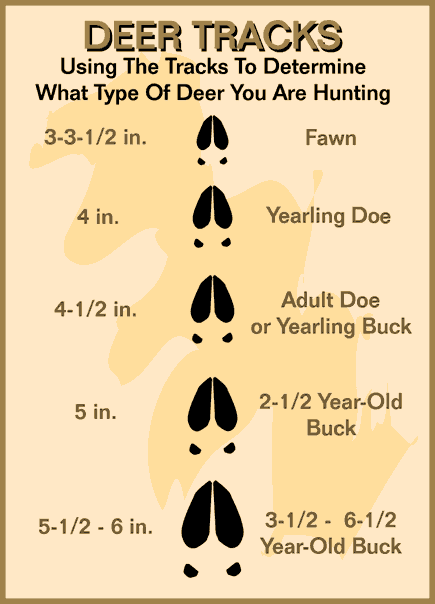Doe tracks follow an easily recognized pattern. Typically, the rear track will contact the ground slightly outside the front track. The track shown in this photo was probably made by a doe. TRACK SIZE VS. BUCK SIZE Fresh tracks can help us to determine which portion of our hunting area offers the best chances for producing a successful day of still-hunting.
Tracks are the very best indicator you have of a buck's body size. In most cases, big tracks mean a mature buck and a mature buck usually has a good rack - at least compared to others in the area. Even if a big buck doesn't rub big trees, he can't completely hide his tracks. Just make sure you are looking at a walking track and not a running track. All running tracks appear much larger than walking tracks and distort the size of the deer that made them. Tracks will also tell you the direction of travel, and with a little detective work, the approximate time of travel. Tracks that point away from a known bedding area were probably made in the afternoon or evening and vice versa.

This chart offers a size comparison for the front hoof of deer of both sexes and different ages. The most reliable indicator of sex and age is the measurement from hoof tip to the dew claw (overall length). Anything 5 1/2 inches, or larger, should be considered a mature buck.
BUCK OR DOE?
 Large bucks make large tracks. This track was definitely made by a mature buck. When walking on even ground a doe's back hooves will tend to fall right on top of her front hooves or slightly outside of them due to the fact that her chest is narrower than her hindquarters. However, since a mature buck tends to have a wider chest than hindquarters, his rear tracks will usually fall to the inside of his front tracks. They will often fall well short of his front tracks and be toed out slightly, as well.
Large bucks make large tracks. This track was definitely made by a mature buck. When walking on even ground a doe's back hooves will tend to fall right on top of her front hooves or slightly outside of them due to the fact that her chest is narrower than her hindquarters. However, since a mature buck tends to have a wider chest than hindquarters, his rear tracks will usually fall to the inside of his front tracks. They will often fall well short of his front tracks and be toed out slightly, as well. by: Hunting Net

No comments:
Post a Comment